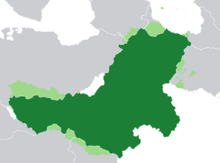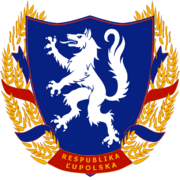Luepolan language: Difference between revisions
| Line 196: | Line 196: | ||
==Grammar== | ==Grammar== | ||
Luepolan grammar is primarily [[wikipedia:fusional language|fusional]]; adjectives, nouns, and verbs alike undergo {{wpl|declension}} and {{wp|conjugation}} to specify their function and meaning. A small number of {{wpl|clitics}} are additionally present, such as ''naj'' and ''se-'', which are separate from the main processes of grammatical alteration. | |||
The primary parts of speech of Luepolan are nouns, verbs, adjectives, adverbs, numbers, prepositions, conjunctions, and interrogatives. | |||
===Word Order and Sentence Structure=== | |||
===Noun and Adjective declension=== | |||
Like most other Molvic languages, Luepolan nouns possess an inherent gender, and decline to show case and number. | |||
====Case==== | |||
Luepolan features six cases. The first two cases, the [[wikipedia:nominative case|nominative]] and [[wikipedia:accusative case|accusative]], distinguish the subject of the sentence and direct objects, while the remaining four denote indirect objects ([[wikipedia:dative case|dative]]) as well as various prepositional objects and other syntactic relationships between the word and the phrase. Luepolan, much like {{wpl|Russian language|Venayan}} and {{wpl|Slovene language|Zacotian}}, lost use of the Proto-Molvic vocative case present in other Molvic languages. Adjectives are also declined by these cases to match the case of the noun they modify. | |||
{| class="wikitable" | |||
|- | |||
!No. || Luepolan name || Case || Main usage | |||
|- | |||
|1. || ''Benenni'' || [[wikipedia:nominative case|nominative]] || Subjects | |||
|- | |||
|2. || ''Anklagni'' || [[wikipedia:accusative case|accusative]] || Noun adjuncts, possession, prepositions of motion, time and location | |||
|- | |||
|3. || ''Coigeni'' || [[wikipedia:genitive case|genitive]] || Indirect objects, prepositions of motion | |||
|- | |||
|4. || ''Gebenni'' || [[wikipedia:dative case|dative]] || Direct objects, prepositions of motion and time | |||
|- | |||
|5. || ''Ortovani'' || [[wikipedia:locative case|locative]] || Prepositions of location, time and topic | |||
|- | |||
|6. || ''Vomeni'' || [[wikipedia:instrumental case|instrumental]] || Passive agents, instruments, prepositions of location | |||
|} | |||
====Gender==== | |||
Luepolan features three distinct genders: [[wikipedia:masculine gender|masculine]] (''Múžănski''), [[wikipedia:feminine gender|feminine]] (''Ženăvski''), and [[wikipedia:neuter gender|neuter]] (''Sřédovi''). The genders of words are inherited from Proto-Molvic, or from the source language if it is a loanword (frequently {{wpl|German language|Vierz}}), and as such do not fully correspond to orthographic or phonologic features. Nonetheless, certain patterns may be approximated to help new learners of the language discern the gender of a noun. These features are furthermore considered 'normative' or standard features for words of their given gender. | |||
* Nouns ending in -e or -o will always be neuter. The former is considered standard if the preceding consonant is 'soft'; otherwise, the latter is considered standard for neuter nouns. | |||
* Nouns ending in -ija will always be feminine. | |||
* Nouns ending in -a will usually be feminine; this is considered the standard form for feminine words. | |||
* Nouns ending in a 'hard' consonant will usually be masculine. | |||
* Nouns ending in a 'soft' consonant (ć, đ, ľ, ň, ř, ť) will often be feminine. | |||
Luepolan additionally possesses a system by which certain nouns, usually masculine, can be altered to form words of a new gender. For example, the irregular masculine ''bali'' (physician) can be altered to form ''bala'' (female physician). This method is acknowledged by the Luepolan Language Society as a method for producing new feminine and neuter nouns, rather than as a method of altering original nouns; in the given example, ''bali'' and ''bala'' would receive separate dictionary entries. | |||
==Borrowed words== | ==Borrowed words== | ||
Revision as of 15:47, 3 April 2020
This article is incomplete because it is pending further input from participants, or it is a work-in-progress by one author. Please comment on this article's talk page to share your input, comments and questions. Note: To contribute to this article, you may need to seek help from the author(s) of this page. |
| Luepolan | |
|---|---|
| Ľupolski Ézik | |
| Native to | Luepola |
Native speakers | 83 million (2013) |
| |
| Official status | |
Official language in | |
Recognised minority language in | |
| Regulated by | Academic Society for the Luepolan Language |
| Language codes | |
| ISO 639-3 | lup |
 Areas where Luepolan is spoken by over 50% of the population Areas where Luepolan is spoken by at least 10% of the population | |
Luepolan (/luˈpoʊlən/), or the Luepolan language (Ľupolski ézik [ʎuˈpɔlski e:ˈzik]) is a South Molvic language that evolved in eastern Patyria. It is spoken by approximately 83 million speakers worldwide, the majority of whom live in Luepola, where it is the sole national language.
History
Geographic Distribution
Dialects
Phonology
| Labial | Alveolar | Post- alveolar |
Palatal | Velar | Glottal | ||
|---|---|---|---|---|---|---|---|
| Nasal | m | n | ɲ | ||||
| Plosive | voiceless | p | t | c | k | ||
| voiced | b | d | ɟ | ɡ | |||
| Affricate | voiceless | t͡s | t͡ʃ | ||||
| voiced | d͡z | d͡z | |||||
| Fricative | voiceless | (f) | s | ʃ | x | ||
| voiced | v | z | ʒ | h | |||
| Tap | ɾ | ||||||
| Trill | plain | r | |||||
| fricative | r̝ | ||||||
| Approximant | plain | r | j | ||||
| lateral | l | ʎ | |||||
| Front | Back | |||
|---|---|---|---|---|
| short | long | short | long | |
| Close | i | iː | u | uː |
| Mid | e | eː | ɔ | (ɔː) |
| Open | a | aː | ||
Orthography
Grammar
Luepolan grammar is primarily fusional; adjectives, nouns, and verbs alike undergo declension and conjugation to specify their function and meaning. A small number of clitics are additionally present, such as naj and se-, which are separate from the main processes of grammatical alteration.
The primary parts of speech of Luepolan are nouns, verbs, adjectives, adverbs, numbers, prepositions, conjunctions, and interrogatives.
Word Order and Sentence Structure
Noun and Adjective declension
Like most other Molvic languages, Luepolan nouns possess an inherent gender, and decline to show case and number.
Case
Luepolan features six cases. The first two cases, the nominative and accusative, distinguish the subject of the sentence and direct objects, while the remaining four denote indirect objects (dative) as well as various prepositional objects and other syntactic relationships between the word and the phrase. Luepolan, much like Venayan and Zacotian, lost use of the Proto-Molvic vocative case present in other Molvic languages. Adjectives are also declined by these cases to match the case of the noun they modify.
| No. | Luepolan name | Case | Main usage |
|---|---|---|---|
| 1. | Benenni | nominative | Subjects |
| 2. | Anklagni | accusative | Noun adjuncts, possession, prepositions of motion, time and location |
| 3. | Coigeni | genitive | Indirect objects, prepositions of motion |
| 4. | Gebenni | dative | Direct objects, prepositions of motion and time |
| 5. | Ortovani | locative | Prepositions of location, time and topic |
| 6. | Vomeni | instrumental | Passive agents, instruments, prepositions of location |
Gender
Luepolan features three distinct genders: masculine (Múžănski), feminine (Ženăvski), and neuter (Sřédovi). The genders of words are inherited from Proto-Molvic, or from the source language if it is a loanword (frequently Vierz), and as such do not fully correspond to orthographic or phonologic features. Nonetheless, certain patterns may be approximated to help new learners of the language discern the gender of a noun. These features are furthermore considered 'normative' or standard features for words of their given gender.
- Nouns ending in -e or -o will always be neuter. The former is considered standard if the preceding consonant is 'soft'; otherwise, the latter is considered standard for neuter nouns.
- Nouns ending in -ija will always be feminine.
- Nouns ending in -a will usually be feminine; this is considered the standard form for feminine words.
- Nouns ending in a 'hard' consonant will usually be masculine.
- Nouns ending in a 'soft' consonant (ć, đ, ľ, ň, ř, ť) will often be feminine.
Luepolan additionally possesses a system by which certain nouns, usually masculine, can be altered to form words of a new gender. For example, the irregular masculine bali (physician) can be altered to form bala (female physician). This method is acknowledged by the Luepolan Language Society as a method for producing new feminine and neuter nouns, rather than as a method of altering original nouns; in the given example, bali and bala would receive separate dictionary entries.
